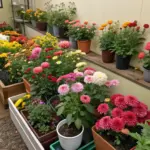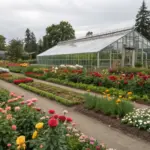10. Celosia: The Bold and Textural Star of the Garden

If you’re looking to add some serious drama to your cutting garden, celosia is here to deliver. With its unique textures—from feathery plumes to brain-like crests and spiky towers—this flower is anything but ordinary. And bonus: it’s incredibly heat-tolerant, making it a no-brainer for warmer climates like Dallas-Ft. Worth or Houston. Whether you’re into avant-garde designs or architectural arrangements, celosia is ready to push creative boundaries. Let’s explore why this bold bloom deserves a spot in your garden and how to make it shine in your floral creations.
Unique Textures of Celosia: Plumes, Crests, and Spikes
Celosia is like the chameleon of the flower world—it comes in so many shapes and textures that it’s hard not to fall in love. There are three main types:
- Plumed celosia (Celosia argentea) looks like soft, velvety feathers in vibrant colors like red, orange, and yellow.
- Crested celosia (Celosia cristata), also known as “cockscomb,” has those iconic brain-like shapes that feel almost otherworldly.
- Spiked celosia (Celosia spicata) grows in upright, geometric spikes that scream modern minimalism.
I’ll never forget the first time I grew crested celosia—it felt like I had alien plants in my garden! Their textures are so unique that they instantly become conversation starters, whether in the garden or in a vase.
Pro tip: Mix different types of celosia together for a dynamic display. The contrast between the soft plumes and the structured spikes is pure magic.
Heat-Tolerant Qualities Perfect for Warmer Climates
Let’s talk about one of celosia’s superpowers: its ability to thrive in heat. If you’ve ever struggled to keep flowers alive during scorching summers, celosia is your answer. These tough blooms can handle high temperatures and even drought conditions once established.
I live in a hot climate, and I’ve found that celosia is one of the few flowers that doesn’t just survive but thrives in the heat. They’re perfect for places like Dallas-Ft. Worth or Houston, where summer feels like an eternal sauna. Plus, their bright colors don’t fade in the sun, which is a huge win when you’re growing flowers for cutting.
Here’s what works best: plant them in well-draining soil and give them plenty of sunlight. They’re low-maintenance but do appreciate regular watering during dry spells—just don’t overdo it, as they hate soggy roots.
Experimenting with Celosia in Avant-Garde or Architectural Designs
When it comes to styling celosia, think outside the box. These blooms are perfect for avant-garde or architectural floral designs because of their bold shapes and vivid colors.
For a modern look, use spiked celosia in minimalist arrangements with clean lines. Pair them with succulents or dried grasses for a sleek, contemporary vibe. I once made a centerpiece using only celosia spikes and black sand in a geometric vase—it was so striking that guests couldn’t stop asking about it.
If you’re feeling artsy, go all-in with crested celosia. Their brain-like shapes are perfect for creating whimsical, surreal bouquets. Combine them with unexpected elements like metallic accents or unconventional containers for a truly unique design.
And don’t forget about plumed celosia—they’re great for adding softness and movement to arrangements. Try mixing them with bold blooms like dahlias or zinnias for a bouquet that feels both playful and polished.
Conclusion
Creating a gorgeous DIY cutting garden doesn’t have to be intimidating—it’s all about choosing the right blooms and nurturing them with love. From the cheerful zinnias to the luxurious ranunculus, these 10 must-grow flowers will transform your outdoor space into a haven of color and creativity.
Ready to start planting? Grab your gardening gloves, pick up some seeds, and let’s bring your vision to life! Don’t forget to tag us in photos of your blooming masterpieces—we’d love to see what you create. Happy gardening!










GIPHY App Key not set. Please check settings